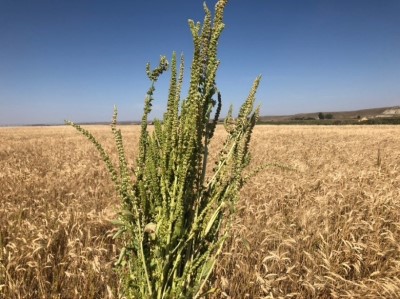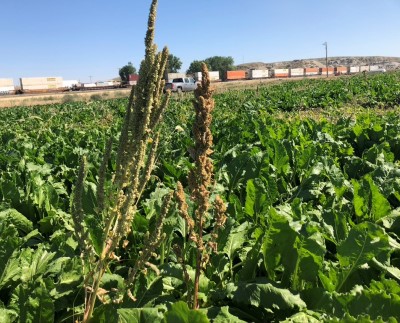Waterhemp (Amaranthus tuberculatus)
Introduction

Photo by Tim Seipel, MSU.
Waterhemp (Amaranthus tuberculatus) is a pigweed native to North America. This weed of crop fields, especially soybean and corn in the Midwest, is problematic because of prolific seed production and evolved herbicide resistance. In August 2020 we documented the first population in Montana. Waterhemp was found in a wheat and an adjacent sugar beet field in Roosevelt county. In the 1990s waterhemp was identified in eastern North Dakota and has rapidly spread there over the last decade; more recently it has spread farther west. Resistance to ALS-inhibiting herbicides (Group 2, e.g. Glean, Ally) and glyphosate (Group 9) is so widespread that we assume resistance to both modes of action. Herbicide resistance complicates management and increases the threat to Montana’s crop production. Waterhemp has been ranked as one of the most troublesome weeds to manage according to the Weed Science Society of America.
Identification and Biology

Waterhemp plant on left, red root pigweed plant on right. Photo by Tim Seipel, MSU.
Waterhemp is an annual in the pigweed family (Amaranthaceae). Other pigweeds in Montana include red root pigweed, which can look very similar to waterhemp. Stems of waterhemp are smooth and lack hairs, which help to distinguish it from red root pigweed which has fuzzy hairs along the stem. Its inflorescence is longer, thinner, and more branched than that of red root pigweed. Leaves are egg shaped and have a long petiole (leaf stem). Unlike red root pigweed, water hemp is dioecious (separate male and female plants). Because of this, waterhemp must outcross to make seed, and genetic diversity is high meaning the species can adapt readily to different environments. Waterhemp can germinate throughout the growing season but typically does so May through June.
Habitat and Spread
Waterhemp is mostly found in croplands but also occurs in wet areas along sloughs or in disturbed areas such as roadsides and waste areas. It can be very problematic in irrigated fields.
Impacts
Waterhemp reduces crop yields especially when infestations are dense, and herbicides have been mostly ineffective at controlling the species. There are effective herbicides in corn and soybean, but limited post-emergent options for pulse crops, flax, canola, sunflower and other minor crops make control very difficult.
Management Options
Since waterhemp has only been documented once in Montana, be on the lookout. Early identification and control are key to minimizing its spread and impact. Monitor fields and field edges, and keep equipment clean as it is one of the easiest ways to move pigweed seed from one area to another. Research has shown that herbicide programs include multiple applications of residual herbicides. If you suspect you have waterhemp, contact your local Extension agent. Montana State University is committed to helping to limit the spread and manage the species (https://ipm.montana.edu/cropweeds/).
Further Information
For more information on this month's weed post, contact MSU Extension Cropland Weed Specialist Tim Seipel. Past posts are available in the Monthly Weed Post Directory.
This month's Weed Post is also available as a Printable PDF (350 KB).
